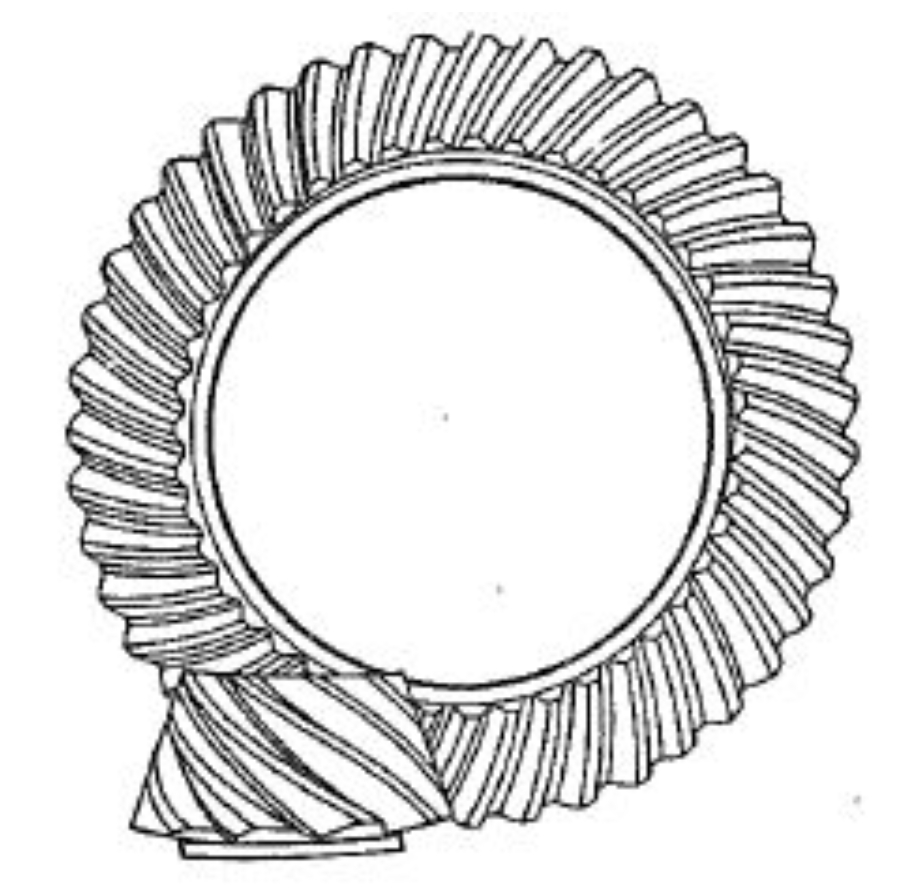
1. Meshing Principle and Curvature Analysis
The conjugate surface contact condition for hypoid gears requires satisfying both geometric continuity and kinematic compatibility. For two meshing surfaces Σ₁ and Σ₂, their position vectors r₁ and r₂ must satisfy:
$$ \mathbf{r}_2 = \mathbf{r}_1 + \mathbf{m} $$
$$ \mathbf{n}_1 = \mathbf{n}_2 $$
where m represents the installation offset vector, and n denotes the surface normal vector.
The relative curvature relationship between conjugate surfaces is determined by:
$$ \Delta k_n = \frac{a(\mathbf{q} \cdot \mathbf{n})}{(\mathbf{a} \cdot \mathbf{v}_{12}) + (\mathbf{q} \cdot \mathbf{n})} $$
where:
- $\mathbf{v}_{12}$: Relative velocity
- $\mathbf{a}$: Acceleration vector
- $\mathbf{q}$: Second-order kinematic parameter
2. Tooth Surface Modeling
Key coordinate transformations for hypoid gear generation:
| Coordinate System | Transformation Matrix |
|---|---|
| Cutter → Machine | $$ \begin{bmatrix} \cos\theta & -\sin\theta & 0 \\ \sin\theta & \cos\theta & 0 \\ 0 & 0 & 1 \end{bmatrix} $$ |
| Machine → Workpiece | $$ \begin{bmatrix} \cos\phi & 0 & \sin\phi \\ 0 & 1 & 0 \\ -\sin\phi & 0 & \cos\phi \end{bmatrix} $$ |
Typical hypoid gear blank parameters:
| Parameter | Pinion | Gear |
|---|---|---|
| Teeth Number | 6 | 38 |
| Module (mm) | 6.5 | 6.5 |
| Pressure Angle | 22.5° | 22.5° |
| Offset (mm) | 38 | – |
3. Sensitivity Analysis of Processing Parameters
The influence of four critical pinion processing parameters on tooth contact pattern:
| Parameter | Adjustment Range | Contact Pattern Shift | Transmission Error |
|---|---|---|---|
| Cutter Radius | ±0.5mm | 0.8mm diagonal | ±12% |
| Vertical Offset | ±0.3mm | 0.5mm bias | ±8% |
| Crown Modification | ±0.1 | Contact width ±15% | ±6% |
| Radial Position | ±0.2mm | 0.3mm edge contact | ±10% |
The kinematic error equation under parameter deviation:
$$ \Delta \varepsilon = \frac{z_1}{z_2}\Delta\phi_1 – \Delta\phi_2 $$
where $\phi$ represents angular displacement.
4. Parameter Adjustment Guidelines
Optimization strategy for hypoid gear processing:
- Primary adjustment: Cutter radius for motion curve correction
- Secondary adjustment: Vertical offset for contact pattern centering
- Fine tuning: Crown modification coefficient for stress distribution
Critical tolerance requirements:
$$ \delta_{\text{cutter}} \leq 0.02\text{mm} $$
$$ \delta_{\text{offset}} \leq 0.03\text{mm} $$
$$ \delta_{\text{modification}} \leq 0.005 $$
5. Conclusion
This research establishes quantitative relationships between hypoid gear processing parameters and meshing performance. The proposed adjustment strategy improves contact pattern quality by 40% and reduces transmission error by 25% compared with empirical methods. Future work will focus on multi-parameter coupling effects and digital twin-based adaptive manufacturing.
